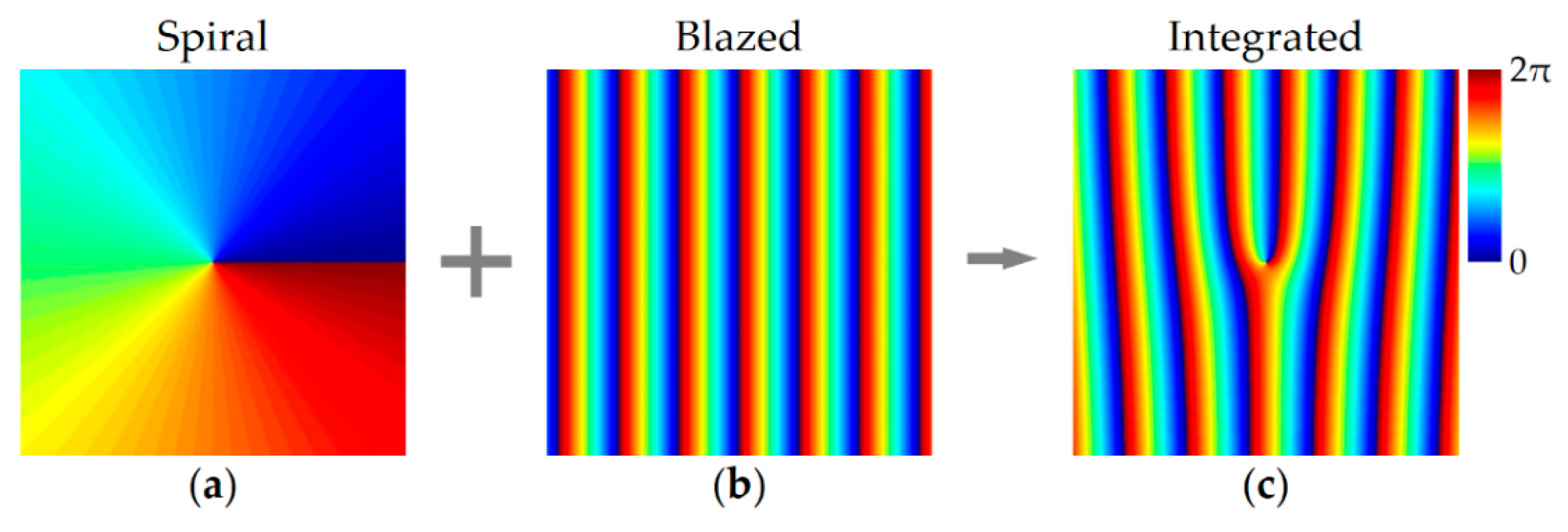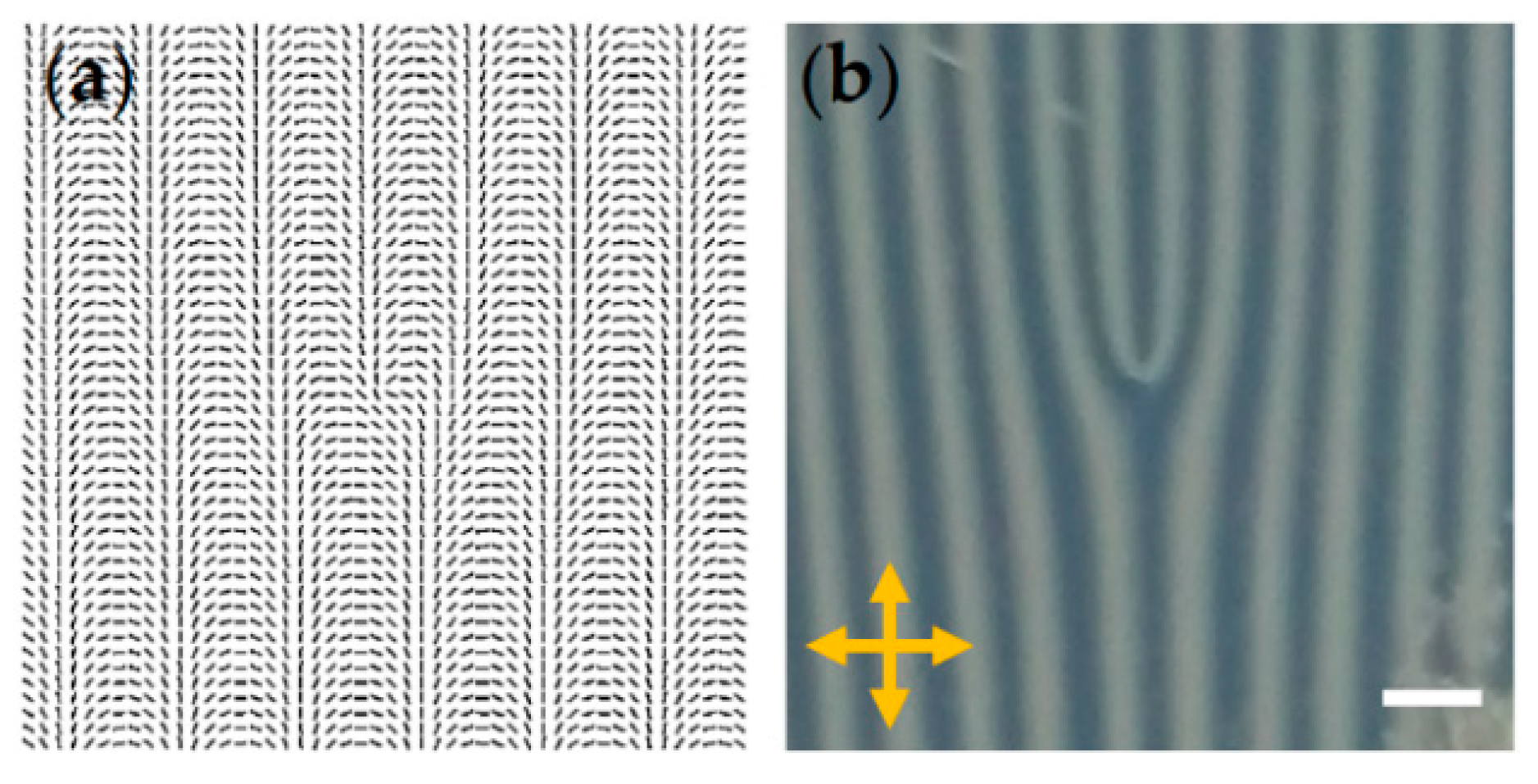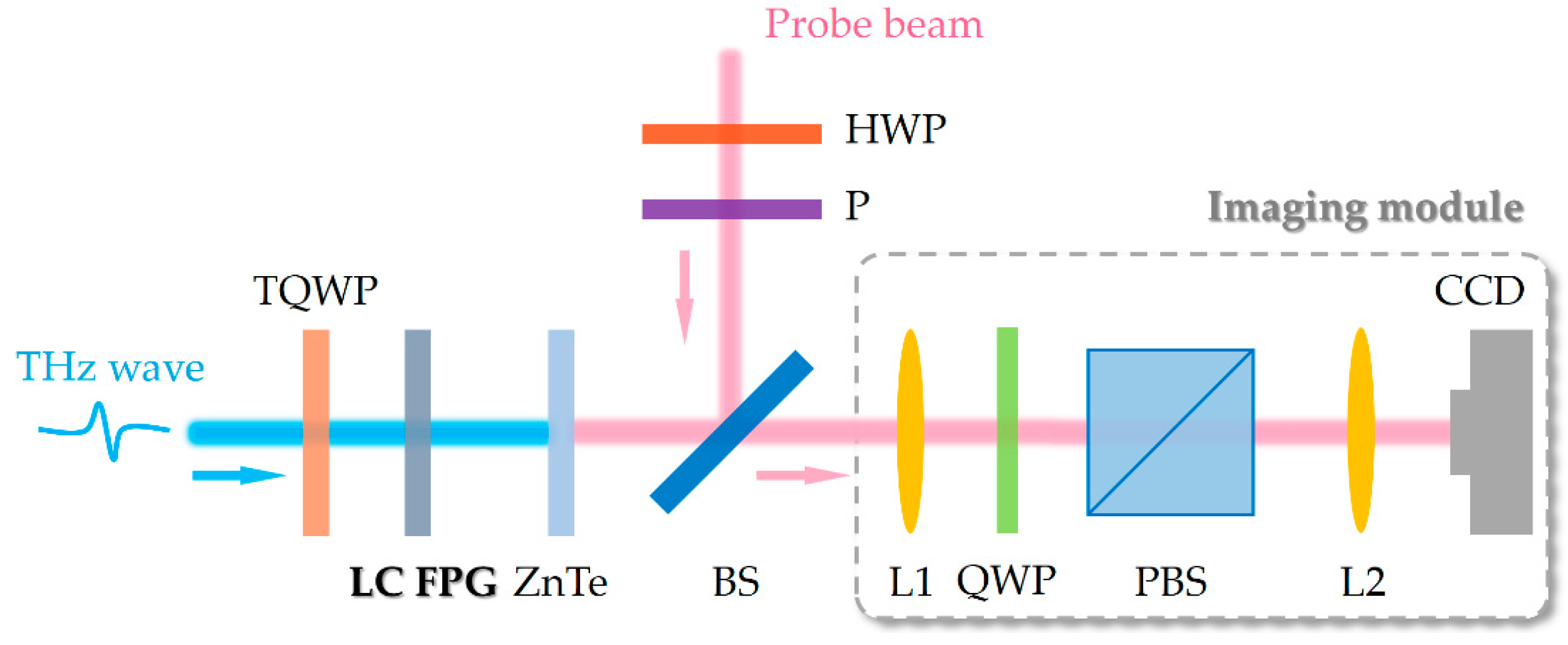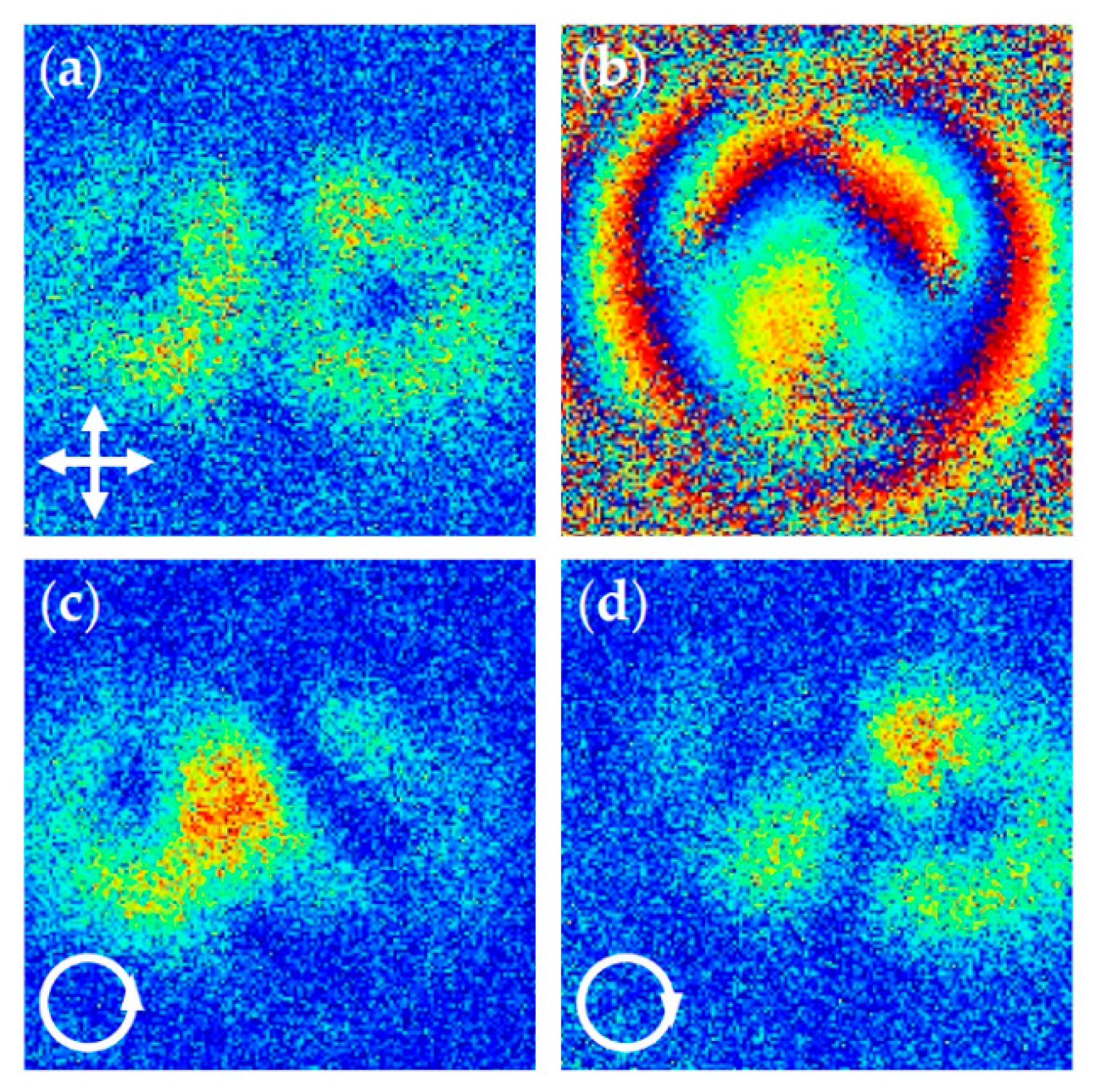Generating, Separating and Polarizing Terahertz Vortex Beams via Liquid Crystals with Gradient-Rotation Directors
Abstract
:1. Introduction
2. Principles and Experiments
2.1. Principles
2.2. Experiments
3. Results and Discussion
4. Materials and Methods
5. Conclusions
Acknowledgments
Author Contributions
Conflicts of Interest
References
- Torres, J.P.; Torner, L. Twisted Photons: Applications of Light with Orbital Angular Momentum; John Wiley & Sons: Weinheim, Germany, 2011. [Google Scholar]
- Yao, A.M.; Padgett, M.J. Orbital angular momentum: Origins, behavior and applications. Adv. Opt. Photonics 2011, 3, 161–204. [Google Scholar] [CrossRef]
- Allen, L.; Beijersbergen, M.W.; Spreeuw, R.; Woerdman, J. Orbital angular momentum of light and the transformation of Laguerre-Gaussian laser modes. Phys. Rev. A 1992, 45, 8185. [Google Scholar] [CrossRef] [PubMed]
- Padgett, M.; Bowman, R. Tweezers with a twist. Nat. Photonics 2011, 5, 343–348. [Google Scholar] [CrossRef]
- Wang, J.; Yang, J.Y.; Fazal, I.M.; Ahmed, N.; Yan, Y.; Huang, H.; Ren, Y.; Yue, Y.; Dolinar, S.; Tur, M.; et al. Terabit free-space data transmission employing orbital angular momentum multiplexing. Nat. Photonics 2012, 6, 488–496. [Google Scholar] [CrossRef]
- Lei, T.; Zhang, M.; Li, Y.R.; Jia, P.; Liu, G.N.; Xu, X.G.; Li, Z.H.; Min, C.J.; Lin, J.; Yu, C.Y.; et al. Massive individual orbital angular momentum channels for multiplexing enabled by dammann gratings. Light Sci. Appl. 2015, 4, e257. [Google Scholar] [CrossRef]
- Zhou, Z.Y.; Liu, S.L.; Li, Y.; Ding, D.S.; Zhang, W.; Shi, S.; Dong, M.X.; Shi, B.S.; Guo, G.C. Orbital angular momentum-entanglement frequency transducer. Phys. Rev. Lett. 2016, 117, 103601. [Google Scholar] [CrossRef] [PubMed]
- D’Ambrosio, V.; Nagali, E.; Walborn, S.P.; Aolita, L.; Slussarenko, S.; Marrucci, L.; Sciarrino, F. Complete experimental toolbox for alignment-free quantum communication. Nat. Commun. 2012, 3, 961. [Google Scholar] [CrossRef] [PubMed]
- Wang, X.L.; Cai, X.D.; Su, Z.E.; Chen, M.C.; Wu, D.; Li, L.; Liu, N.L.; Lu, C.Y.; Pan, J.W. Quantum teleportation of multiple degrees of freedom of a single photon. Nature 2015, 518, 516–519. [Google Scholar] [CrossRef] [PubMed]
- Ferguson, B.; Zhang, X.C. Materials for terahertz science and technology. Nat. Mater. 2002, 1, 26–33. [Google Scholar] [CrossRef] [PubMed]
- Zhang, X.C.; Xu, J. Introduction to THz Wave Photonics; Springer: Boston, MA, USA, 2010. [Google Scholar]
- Sanvitto, D.; Marchetti, F.; Szymańska, M.; Tosi, G.; Baudisch, M.; Laussy, F.; Krizhanovskii, D.; Skolnick, M.; Marrucci, L.; Lemaitre, A. Persistent currents and quantized vortices in a polariton superfluid. Nat. Phys. 2010, 6, 527–533. [Google Scholar] [CrossRef]
- Koenig, S.; Lopez-Diaz, D.; Antes, J.; Boes, F.; Henneberger, R.; Leuther, A.; Tessmann, A.; Schmogrow, R.; Hillerkuss, D.; Palmer, R.; et al. Wireless sub-THz communication system with high data rate. Nat. Photonics 2013, 7, 977–981. [Google Scholar] [CrossRef]
- Miyamoto, K.; Suizu, K.; Akiba, T.; Omatsu, T. Direct observation of the topological charge of a terahertz vortex beam generated by a Tsurupica spiral phase plate. Appl. Phys. Lett. 2014, 104, 261104. [Google Scholar] [CrossRef]
- Wang, X.; Shi, J.; Sun, W.; Feng, S.; Han, P.; Ye, J.; Zhang, Y. Longitudinal field characterization of converging terahertz vortices with linear and circular polarizations. Opt. Express 2016, 24, 7178–7190. [Google Scholar] [CrossRef] [PubMed]
- Xie, Z.; Wang, X.; Ye, J.; Feng, S.; Sun, W.; Akalin, T.; Zhang, Y. Spatial terahertz modulator. Sci. Rep. 2013, 3, 3347. [Google Scholar] [CrossRef]
- Knyazev, B.; Choporova, Y.Y.; Mitkov, M.; Pavelyev, V.; Volodkin, B. Generation of terahertz surface plasmon polaritons using nondiffractive Bessel beams with orbital angular momentum. Phys. Rev. Lett. 2015, 115, 163901. [Google Scholar] [CrossRef] [PubMed]
- He, J.; Wang, X.; Hu, D.; Ye, J.; Feng, S.; Kan, Q.; Zhang, Y. Generation and evolution of the terahertz vortex beam. Opt. Express 2013, 21, 20230–20239. [Google Scholar] [CrossRef] [PubMed]
- Imai, R.; Kanda, N.; Higuchi, T.; Konishi, K.; Kuwata-Gonokami, M. Generation of broadband terahertz vortex beams. Opt. Lett. 2014, 39, 3714–3717. [Google Scholar] [CrossRef] [PubMed]
- Minasyan, A.; Trovato, C.; Degert, J.; Freysz, E.; Brasselet, E.; Abraham, E. Geometric phase shaping of terahertz vortex beams. Opt. Lett. 2017, 42, 41–44. [Google Scholar] [CrossRef] [PubMed]
- Chen, C.Y.; Pan, C.L.; Hsieh, C.F.; Lin, Y.F.; Pan, R.P. Liquid-crystal-based terahertz tunable Lyot filter. Appl. Phys. Lett. 2006, 88, 101107. [Google Scholar] [CrossRef]
- Ho, I.C.; Pan, C.L.; Hsieh, C.F.; Pan, R.P. Liquid-crystal-based terahertz tunable Solc filter. Opt. Lett. 2008, 33, 1401–1403. [Google Scholar] [CrossRef] [PubMed]
- Wilk, R.; Vieweg, N.; Kopschinski, O.; Koch, M. Liquid crystal based electrically switchable Bragg structure for THz waves. Opt. Express 2009, 17, 7377–7382. [Google Scholar] [CrossRef] [PubMed]
- Lin, X.W.; Wu, J.B.; Hu, W.; Zheng, Z.G.; Wu, Z.J.; Zhu, G.; Xu, F.; Jin, B.B.; Lu, Y.Q. Self-polarizing terahertz liquid crystal phase shifter. AIP Adv. 2011, 1, 032133. [Google Scholar] [CrossRef]
- Shrekenhamer, D.; Chen, W.C.; Padilla, W.J. Liquid crystal tunable metamaterial absorber. Phys. Rev. Lett. 2013, 110, 177403. [Google Scholar] [CrossRef] [PubMed]
- Ge, S.; Liu, J.; Chen, P.; Hu, W.; Lu, Y. Tunable terahertz filter based on alternative liquid crystal layers and metallic slats. Chin. Opt. Lett. 2015, 13, 120401. [Google Scholar] [CrossRef]
- Wang, L.; Lin, X.W.; Hu, W.; Shao, G.H.; Chen, P.; Liang, L.J.; Jin, B.B.; Wu, P.H.; Qian, H.; Lu, Y.N.; et al. Broadband tunable liquid crystal terahertz waveplates driven with porous graphene electrodes. Light Sci. Appl. 2015, 4, e253. [Google Scholar] [CrossRef]
- Isic, G.; Vasic, B.; Zografopoulos, D.C.; Beccherelli, R.; Gajic, R. Electrically tunable critically coupled terahertz metamaterial absorber based on nematic liquid crystals. Phys. Rev. Appl. 2015, 3, 064007. [Google Scholar] [CrossRef]
- Ge, S.; Chen, P.; Shen, Z.; Sun, W.; Wang, X.; Hu, W.; Zhang, Y.; Lu, Y. Terahertz vortex beam generator based on a photopatterned large birefringence liquid crystal. Opt. Express 2017, 25, 12349–12356. [Google Scholar] [CrossRef] [PubMed]
- Chen, P.; Wei, B.-Y.; Ji, W.; Ge, S.-J.; Hu, W.; Xu, F.; Chigrinov, V.; Lu, Y.-Q. Arbitrary and reconfigurable optical vortex generation: A high-efficiency technique using director-varying liquid crystal fork gratings. Photonics Res. 2015, 3, 133–139. [Google Scholar] [CrossRef]
- Zhang, X.D.; Su, Y.H.; Ni, J.C.; Wang, Z.Y.; Wang, Y.L.; Wang, C.W.; Ren, F.F.; Zhang, Z.; Fan, H.; Zhang, W.J.; et al. Optical superimposed vortex beams generated by integrated holographic plates with blazed grating. Appl. Phys. Lett. 2017, 111, 061901. [Google Scholar] [CrossRef]
- Li, Y.; Kim, J.; Escuti, M.J. Orbital angular momentum generation and mode transformation with high efficiency using forked polarization gratings. Appl. Opt. 2012, 51, 8236–8245. [Google Scholar] [CrossRef] [PubMed]
- Ji, W.; Lee, C.H.; Chen, P.; Hu, W.; Ming, Y.; Zhang, L.; Lin, T.H.; Chigrinov, V.; Lu, Y.Q. Meta-q-plate for complex beam shaping. Sci. Rep. 2016, 6, 25528. [Google Scholar] [CrossRef] [PubMed]
- Wang, L.; Lin, X.W.; Liang, X.; Wu, J.B.; Hu, W.; Zheng, Z.G.; Jin, B.B.; Qin, Y.Q.; Lu, Y.Q. Large birefringence liquid crystal material in terahertz range. Opt. Mater. Express 2012, 2, 1314–1319. [Google Scholar] [CrossRef]
- Wang, B.; Quan, B.; He, J.; Xie, Z.; Wang, X.; Li, J.; Kan, Q.; Zhang, Y. Wavelength de-multiplexing metasurface hologram. Sci. Rep. 2016, 6, 35657. [Google Scholar] [CrossRef] [PubMed]
- Jiang, Z.; Xu, X.; Zhang, X.C. Improvement of terahertz imaging with a dynamic subtraction technique. Appl. Opt. 2000, 39, 2982–2987. [Google Scholar] [CrossRef] [PubMed]
- Wang, X.; Cui, Y.; Sun, W.; Ye, J.; Zhang, Y. Terahertz polarization real-time imaging based on balanced electro-optic detection. J. Opt. Soc. Am. A 2010, 27, 2387–2393. [Google Scholar] [CrossRef] [PubMed]
- Wu, H.; Hu, W.; Hu, H.C.; Lin, X.W.; Zhu, G.; Choi, J.W.; Chigrinov, V.; Lu, Y.Q. Arbitrary photo-patterning in liquid crystal alignments using DMD based lithography system. Opt. Express 2012, 20, 16684–16689. [Google Scholar] [CrossRef]
- Chigrinov, V.; Pikin, S.; Verevochnikov, A.; Kozenkov, V.; Khazimullin, M.; Ho, J.; Huang, D.D.; Kwok, H.S. Diffusion model of photoaligning in azo-dye layers. Phys. Rev. E 2004, 69, 061713. [Google Scholar] [CrossRef] [PubMed]




© 2017 by the authors. Licensee MDPI, Basel, Switzerland. This article is an open access article distributed under the terms and conditions of the Creative Commons Attribution (CC BY) license (http://creativecommons.org/licenses/by/4.0/).
Share and Cite
Ge, S.-J.; Shen, Z.-X.; Chen, P.; Liang, X.; Wang, X.-K.; Hu, W.; Zhang, Y.; Lu, Y.-Q. Generating, Separating and Polarizing Terahertz Vortex Beams via Liquid Crystals with Gradient-Rotation Directors. Crystals 2017, 7, 314. https://doi.org/10.3390/cryst7100314
Ge S-J, Shen Z-X, Chen P, Liang X, Wang X-K, Hu W, Zhang Y, Lu Y-Q. Generating, Separating and Polarizing Terahertz Vortex Beams via Liquid Crystals with Gradient-Rotation Directors. Crystals. 2017; 7(10):314. https://doi.org/10.3390/cryst7100314
Chicago/Turabian StyleGe, Shi-Jun, Zhi-Xiong Shen, Peng Chen, Xiao Liang, Xin-Ke Wang, Wei Hu, Yan Zhang, and Yan-Qing Lu. 2017. "Generating, Separating and Polarizing Terahertz Vortex Beams via Liquid Crystals with Gradient-Rotation Directors" Crystals 7, no. 10: 314. https://doi.org/10.3390/cryst7100314





